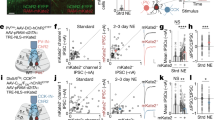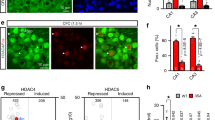Abstract
THE requirement of protein and messenger RNA synthesis for long-term memory1,2 suggests that neural activity induced by learning initiates a cascade of gene expression3. Here we use differential screening to identify five immediate–early genes induced by neuronal activity. One of these is tissue-plasminogen activator (tPA), an extracellular serine protease, which is induced with different spatial patterns in the brain by three activity-dependent events: (1) convulsive seizure increases expression of tPA in the whole brain; (2) stimulation of the perforant path produces an epileptiform after-discharge that ultimately leads to kindling increases the levels of tPA throughout the hippocampus bilaterally; and (3) brief high-frequency stimulation of the perforant path that produces long-term potentiation (LTP) causes an NMDA (N -methyl-D-aspartate) receptor-mediated increase in the levels of tPA mRNA which is restricted to the granule cells of the ipsilateral dentate gyrus. As release of tPA is correlated with morphological differentiation4–6, the increased expression of tPA may play a role in the structural changes that accompany activity-dependent plasticity7–10.
This is a preview of subscription content, access via your institution
Access options
Subscribe to this journal
Receive 51 print issues and online access
$199.00 per year
only $3.90 per issue
Buy this article
- Purchase on Springer Link
- Instant access to full article PDF
Prices may be subject to local taxes which are calculated during checkout
Similar content being viewed by others
References
Davis, H. P. & Squire, L. R. Psychol. Bull. 96, 518–519 (1984).
Montarolo, P. G., Goelet, P., Castellucci, V. F., Morgan, J. I. & Kandel, E. R. Science 234, 1249–1254 (1986).
Goelet, P., Castellucci, V. F., Schacher, S. & Kandel, E. R. Nature 322, 419–422 (1986).
Krystosek, A. & Seeds, N. W. Science 213, 1532–1533 (1981).
Neuman, T., Stephens, R. W., Salonen, E.-M., Timmusk, T. & Vaheri, A. J. Neurosci. Res. 23, 274–281 (1989).
Pittman, R. N., Ivins, J. K. & Buettner, H. M. J. Neurosci. 9, 4269–4286 (1989).
Ben-Ari, T. & Represa, A. Trends Neurosci. 13, 312–318 (1990).
Cavazos, J. E., Golarai, G. & Sutula, T. P. J. Neurosci. 11, 2795–2803 (1991).
Wallace, C. S., Hawrylak, N. & Greenough, W. T. in Long-Term Potentiation (eds Baudry, M. & Davis, J. L.) 189–222 (MIT Press, Cambridge, MA, 1991).
Geinisman, Y. et al. Brain Res. 569, 342–347 (1992).
Bradbury, A., Possenti, R., Shooter, E. & Tirone, F. Proc. natn. Acad. Sci. U.S.A. 88, 3353–3357 (1991).
Fletcher, B. S. et al. J. biol. Chem. 266, 14511–14518 (1991).
Shaw, G. & Kramer, R. Cell 24, 151–260 (1986).
Greenberg, M. E., Greene, L. A. & Ziff, E. B. J. biol. Chem. 260, 14101–14110 (1985).
Morgan, J. I., Cohen, D. R., Hempstead, J. L. & Curran, T. Science 237, 192–197 (1987).
Cole, A. J., Saffen, D. W., Barban, J. M. & Worley, P. F. Nature 340, 474–476 (1989).
Dragunow, M. & Robertson, H. A. Nature 229, 441–442 (1987).
Wisden, W. et al. Neuron. 4, 603–614 (1990).
Racine, R. et al. J. Electroencephalogr. clin. Neurophysiol. 32, 269–279 (1972).
Racine, R. J., Milgram, N. W. & Hafner, S. Brain Res. 260, 217–231 (1983).
McNamara, J. O., Byrne, M. C., Dashieff, R. M. & Fitz, J. G. Prog. Neurobiol. 15, 139–159 (1980).
Gilbert, M. E. & Mack, C. M. Brain Res. 519, 89–96 (1990).
Gerard, R. & Meidell, R. S. A. Rev. Physiol. 51, 245–262 (1989).
Faseli, M. S., Errington, M. L., Dolphin, A. C. & Bliss, T. V. P. Brain Res. 521, 247–253 (1990).
Monard, D. Trends Neurosci. 11, 541–544 (1988).
Hajjar, K. A. J. biol. Chem. 266, 21962–21970 (1991).
Carney, D. H. Proteases in Biological Control and Biotechnology (ed. Cunningham, D. D. & Long, G. L.) 277–282 (Liss, New Yor, 1987).
Sambrook, J., Fritsch, E. F. & Maniatis, T. Molecular Cloning: A Laboratory Manual (Cold Spring Harbor Laboratory Press, New York, 1989).
Almendral, J. et al. Molec. cell. Biol. 8, 2140–2148 (1988).
Author information
Authors and Affiliations
Rights and permissions
About this article
Cite this article
Qian, Z., Gilbert, M., Colicos, M. et al. Tissue-plasminogen activator is induced as an immediate–early gene during seizure, kindling and long-term potentiation. Nature 361, 453–457 (1993). https://doi.org/10.1038/361453a0
Received:
Accepted:
Issue Date:
DOI: https://doi.org/10.1038/361453a0
This article is cited by
-
Parvalbumin interneuron-derived tissue-type plasminogen activator shapes perineuronal net structure
BMC Biology (2022)
-
Tissue Plasminogen Activator Loaded PCL Nanofibrous Scaffold Promoted Nerve Regeneration After Sciatic Nerve Transection in Male Rats
Neurotoxicity Research (2021)
-
Neuronal activity regulates alternative exon usage
Molecular Brain (2020)
-
Long-term potentiation enhancing effect of epileptic insult in the CA1 area is dependent on prior-application of primed-burst stimulation
Experimental Brain Research (2020)
-
Role of t-PA and PAI-1 variants in temporal lobe epilepsy in Chinese Han population
BMC Neurology (2019)
Comments
By submitting a comment you agree to abide by our Terms and Community Guidelines. If you find something abusive or that does not comply with our terms or guidelines please flag it as inappropriate.



